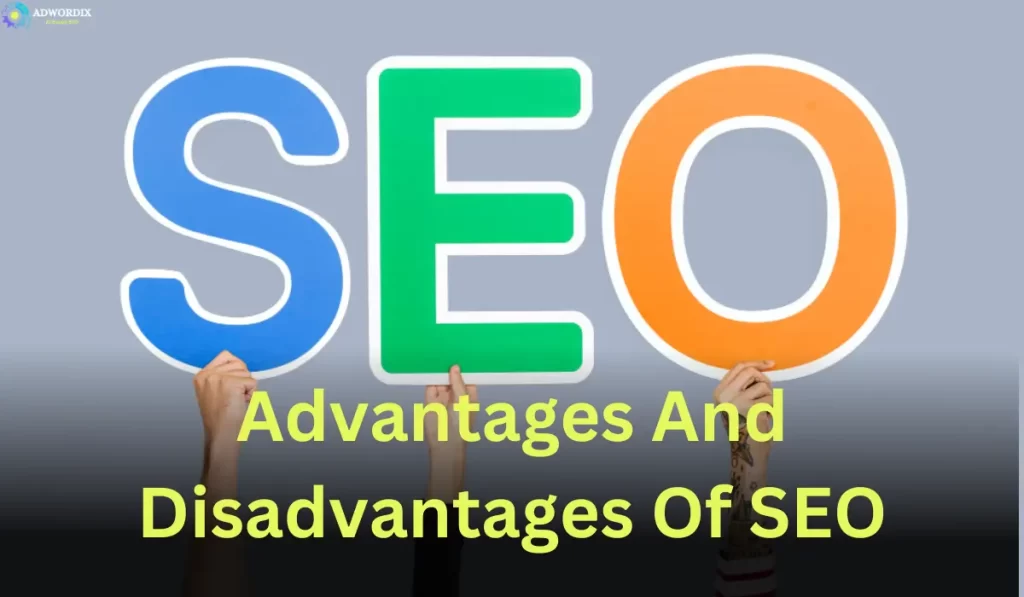Search engine optimization (SEO) has become essential to digital marketing. With the internet being a primary source of information, businesses strive to achieve higher visibility on search engines. Understanding the advantages and disadvantages of SEO helps companies make educated choices regarding their online marketing strategies.
Boosting a website’s visibility in search engine listings is the dynamic and intricate process of search engine optimization (SEO). This optimization is essential to raise brand awareness, improve sales and conversions, and increase organic traffic to your website. We will examine the crucial elements of SEO in this extensive tutorial, including its definition, methods of operation, benefits, and drawbacks. By the end of this article, you will have a clearer understanding of SEO and be better equipped to leverage its benefits while mitigating its challenges.
Advantages of SEO
Increased Visibility and Traffic
The main benefit of SEO is greater visibility in search engines, which leads to higher traffic. This is particularly significant for enterprises seeking to broaden their customer base.
Cost-Effectiveness
Unlike paid advertising, SEO focuses on organic results, which means once you rank well, you don’t have to pay for clicks or impressions. This makes SEO a cost-effective strategy in the long run.
Better User Experience
SEO encourages web admins to create a better user experience. This includes faster loading times, mobile optimization, and relevant content, all contributing to a positive user experience.
Long-Term Results
SEO provides long-term results. While it may take time to see significant improvements, the results are often sustainable and can benefit your website for years.
Credibility and Trust
Higher search engine rankings indicate a website’s dependability and credibility, which can improve your brand’s reputation and foster customer trust.
By implementing effective SEO strategies, businesses can enjoy these advantages and achieve long-term growth and success. Higher recognition of the brand and customer engagement while improving user experience through better site design and faster loading times. This results in greater engagement and lower bounce rates, which benefits SEO and enhances overall customer satisfaction.
Increased Visibility and Traffic
One of SEO’s primary advantages is increasing a website’s visibility in search engine results pages (SERPs). More organic traffic is drawn when a website ranks higher for pertinent keywords. This increased visibility is crucial for brand awareness and reaching a broader audience. For businesses, this means more potential customers discovering their products or services without needing paid advertising.
SEO ensures people actively looking for your goods or services can find your website, attracting higher-quality traffic. Unlike other marketing strategies, where you push content to the audience, SEO allows your audience to see you when they are interested, making it more effective in converting leads into customers.
Cost-Effectiveness
SEO is a cost-effective marketing strategy because, unlike pay-per-click (PPC) advertising, it focuses on organic traffic. SEO requires an initial expenditure of resources and time, but once your website ranks high in search results, the ongoing cost is relatively low compared to PPC campaigns. Organic search results can provide steady traffic without continuous ad spending.
Due to its low cost, SEO is desirable for startups and small companies with tight marketing budgets. SEO can yield long-term benefits, providing an excellent ROI as your site draws in organic traffic over time.
Disadvantages of SEO
Time-Consuming Process
One of SEO’s main disadvantages is that it can be time-consuming. Achieving significant results from SEO efforts often takes several months, if not longer. Unlike paid advertising, which can generate immediate traffic, SEO requires ongoing optimization, content creation, and link-building efforts. Businesses hoping for short-term gains may need help making this long-term commitment.
SEO’s time-consuming nature also requires patience and persistence. Setting reasonable goals and realizing that SEO is a marathon rather than a sprint is crucial. The best outcomes will come from consistent effort over time, but companies must be ready for the long term.
Continuous Monitoring and Updating
SEO requires continuous monitoring and updating; it is not a one-time task. Search engine algorithms constantly evolve, and staying up-to-date with recent developments is crucial to preserving and improving your rankings. This means regularly analyzing your website’s performance, tracking keyword rankings, and adjusting your strategy based on new developments.
Continuous monitoring and updating can be resource-intensive, requiring dedicated personnel or external expertise. This ongoing effort can be a significant challenge for businesses with limited resources. However, neglecting SEO updates can lead to declining rankings and losing organic traffic, making prioritizing this aspect of digital marketing essential.
High Competition
The competitive nature of SEO can be a significant disadvantage, especially for businesses in highly saturated industries. Getting to the top of searches for competitive keywords can be challenging, as many other companies are vying for the same spots. This high level of competition can make it difficult for new or smaller firms to break through and achieve significant visibility.
To overcome this challenge, businesses must focus on niche keywords, create high-quality and unique content, and employ effective link-building strategies. While competition is tough, a well-executed SEO strategy can yield positive results by targeting specific market segments and providing valuable content that stands out.
Potential for Negative SEO
Negative SEO involves unethical practices aimed at sabotaging a competitor’s rankings. This can include building spammy backlinks to a competitor’s site, hacking their website, or engaging in other malicious activities. While negative SEO is not standard, it is a risk that businesses must be aware of.
Protecting your website from negative SEO requires vigilance and proactive measures. Regularly monitoring your backlink profile, using security plugins, and staying informed about potential threats can help mitigate the risk. If you suspect negative SEO, it’s essential to take immediate action to address the issue and protect your website’s rankings.
Uncertainty Due to Algorithm Changes
Search engine algorithms are evolving, and these updates can significantly impact your rankings. While algorithm changes are intended to improve the quality of search results, they can also introduce uncertainty and unpredictability into your SEO strategy. Sudden ranking drops due to algorithm updates can be frustrating and require quick adjustments to regain lost visibility.
Maintaining and raising your ranks requires keeping up with algorithm updates and modifying your SEO plan accordingly. Keeping up with industry news, participating in SEO forums, and regularly auditing your website can help you reduce the effects of algorithm changes and stay ahead of the curve. Understanding what is SEO and how it impacts your site is crucial for staying competitive in the digital landscape.
What is SEO?
SEO improves a website’s position in search engine results pages (SERPs), increasing its exposure and relevance to search engines such as Google, Bing, and Yahoo. SEO’s primary goal is to improve the user experience by increasing a website’s accessibility, informational value, and relevancy to users’ search queries.
How SEO Works
SEO enhances different aspects of a website to make it more attractive to search engines. The main techniques include:
- On-page SEO: involves optimizing a page’s content and HTML source code.
- Off-page SEO: Focuses on building backlinks from other websites to increase the site’s authority.
- Technical SEO: Make sure that a website meets the technical requirements of search engines.
By implementing these strategies, companies can raise the authority and relevancy of their websites in search engine results.
Types & Techniques of SEO
Different SEO practices can be employed based on a business’s goals and ethical considerations.
White-hat SEO
White hat SEO involves using ethical and legitimate techniques to improve a website’s ranking. This includes:
- Creating high-quality content.
- Using descriptive, keyword-rich meta tags.
- Ensuring the website is mobile-friendly.
Black-hat SEO
Black hat SEO uses deceptive practices to manipulate search engine rankings. Search engine guidelines prohibit these tactics, which may lead to penalties. Examples include:
- Keyword stuffing.
- Cloaking: serving search engines with content that is not what users see.
- Using link farms.
Grey Hat SEO
Grey hat SEO falls between white hat and black hat techniques. It involves practices that are not explicitly against guidelines but can be risky. Examples include:
- Using PBNs (Private Blog Networks).
- Purchasing old domains for SEO purposes.
Choosing the correct type of SEO is crucial for long-term success. White hat SEO, while requiring more effort and time, ensures sustainable and ethical growth. Black hat SEO may offer quick results but poses significant risks, including severe penalties from search engines.
Tips to Increase SEO Ranking
Improving your website’s SEO involves a combination of various strategies. To improve your SEO ranking, consider these tips:
- It is vital to create high-quality and relevant content for your audience.
- Websites must be mobile-friendly because more people are accessing the internet through mobile devices.
- A good user experience and fast loading times are important ranking factors.
Conclusion
SEO offers numerous advantages, including increased visibility, cost-effectiveness, better user experience, long-term results, and enhanced credibility. However, it also comes with challenges such as being time-consuming, requiring continuous effort, facing high competition, the risk of negative SEO, and the uncertainty of algorithm changes. By understanding and balancing these pros and cons, Businesses can make wise choices and create efficient SEO strategies. By leveraging SEO’s benefits and addressing its challenges, businesses can build a solid online presence and achieve sustainable growth. While investing in SEO takes time and effort, the rewards of increased traffic, higher rankings, and improved credibility make it worthwhile.





